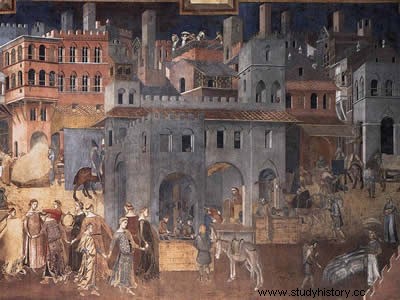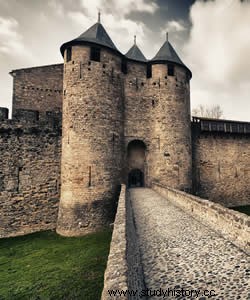
By Tales Pintos
The European Middle Ages was marked by a predominantly rural social and economic organization. The barbarian invasions of the 5th century led to the decline of cities in the Roman Empire, increasing the importance of countryside for housing and economic production. This situation would change from the 11th century onwards when the so-called Urban Renaissance began. .
The ruralization of medieval society did not mean the extinction of cities. It only resulted in the decrease of its importance in the society as a whole, even changing its character compared to the functions performed by the city during Roman Antiquity.
The medieval city – also known as the burg – until the 11th century was, in a way, an extension of the manorial world. As they were located in lands that were dominated by a lord, cities were subject to his power. In addition, the cities mainly inhabited the nobles, kings, bishops and merchants, showing that it was also a space for the concentration of political and religious power. Generally in the center of the cities there are markets and churches.
The lords were able to exert influence over the cities by sending the surpluses of agricultural production from the lands under their control and marketing them in this urban space. They also established dependency relationships between themselves and the city's residents, mainly through the collection of taxes.

Wall of the French medieval city of Carcassone
From the 11th century onwards, trade began to expand as a result of the Crusades and the accumulation of agricultural surpluses. These surpluses were made possible by technical innovations adopted in agriculture, such as the plow, new ways of harnessing animals to the plow and also with the adoption of crop rotation. In this way, the trade with the East made possible by the Crusades and the exchange of surpluses gradually led cities to grow in importance in the feudal world.
To carry out commercial transactions, fairs were created, of which Champagne and Brie, in present-day France, stood out. Because they were fortified and located close to trade routes, cities were considered safe places, mainly to maintain the banking structures necessary for doing business. A class of merchants was formed within the boroughs and also enriched, giving rise to the bourgeois.
On the other hand, groups of artisans were formed who also sold their production at fairs. They began to organize themselves into craft corporations, which were organizations that brought together people who exercised the same profession. Within the corporations there was a rigid division, with the master craftsman at the top, journeymen below him and, finally, apprentices. There were rules in the adoption of production techniques that sought to standardize the forms of work and the products themselves, thus creating a production tradition. It was the role of the master craftsman to ensure compliance with these rules.
As their economic importance increased, cities expanded. More people began to live in cities, resulting in the expansion of the walls that demarcated their limits. However, this growth generated a large agglomeration of people for the numbers of the time. Paris had around 100,000 inhabitants in the period, a considerable number if one takes into account the fact that other cities do not have more than 20,000 inhabitants.
But there were no health practices in these villages. Basic sanitation, as we know it today, did not exist, making cities a place conducive to the spread of epidemics. This is what happened in the 14th century, when fleas infected by the bacterium Yersinia pestis were transported by rodents and animal skins from the East to European cities. Fleas infected by the bacteria, when biting humans, transmit the bubonic plague. In the unsanitary conditions of European cities, the bubonic plague turned into an epidemic that decimated around a third of the European population.

Painting depicting Segovia, a medieval city in Spain
Cities survived the Black Death, another name given to the epidemic. The patriciate that politically controlled the boroughs was strengthened with urban development, generating a growing autonomy from the feudal lords. The commune was the cities that became free and were organized based on relationships different from those that characterized the dependence of the lords of the rural nobility.
These differences grew larger over time and pitted the urban bourgeoisie against the rural nobility. This situation would only be resolved at the end of the Modern Age, when the bourgeoisie had already accumulated considerable economic power to also impose itself politically on the nobility.
* Image credit:Palazzo Pubblica
